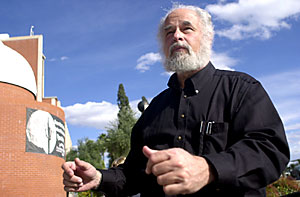 |
|
WILL SEBERGER/Arizona Daily Wildcat
|
Michael Rosenzweig, an ecology and evolutionary biology professor, wants an increase in Sonoran Desert landscaping within the UA and Tucson to make a more favorable habitat for native birds.
|
|
|
By Jessica Lee
Arizona Daily Wildcat
Thursday, March 4, 2004
Print this
Desert landscaping could encroach on campus grass if a UA professor gets his way.
Michael Rosenzweig, an ecology and evolutionary biology professor, said the UA campus could become a more appetizing habitat for the local bird population if officials were to trade the grass for mesquite trees.
"It is unimaginable what this campus could be like," said Rosenzweig. "(The current landscape) was unbelievably badly done."
Due to drastic reductions in Sonoran Desert landscaping over the years, the campus no longer sees a variety of native birds, he said. Rather, house finches, doves and pigeons flood the campus.
"We already spend the money to develop; why not spend it wiser?" Rosenzweig said.
To bring back the native birds, Rosenzweig advocates a new type of ecology he calls "reconciliation ecology." Rather than protect undisturbed wild areas in national parks or wilderness areas, Rosenzweig insists that urban areas could do more to preserve plants and animals by leaving more open space.
The drive to return more local birds to campus would involve integrating the desert with the campus.
"When we look at the local landscape, the campus is different from the surrounding desert landscape. We aren't providing the habitat for the native desert species, (but) rather birds attracted by urban environment," said Mark Novak, a landscape architect within Campus Facilities and Planning.
"People are starting to learn that if you plant local plants, you get local birds. The Campus Arboretum has stated goals that we would like to advocate for more local species," said Libby Davison, director of the Campus Arboretum. "The Joseph Wood Krutch garden is one of those tiny spaces we have on campus."
Novak said it is difficult to create a friendly habitat for birds when 50,000 people are on campus each day.
"We are one of the denser urban campuses in the country," Novak said.
But Rosenzweig said the UA could become a sanctuary for native birds if more desert plants were planted.
"It won't be a good place for sunbathers, but it will be good for birds," he said.
The idea of integrating the desert into the campus landscape has already taken root, thanks to a project Rosenzweig helped initiate: the Tucson Bird Count. Volunteers who participate in the TBC catalog the local birds and vegetation to create a database to document where specific native birds live.
The database helps Rosenzweig gather information about what environments native birds prefer.
"The Tucson Bird Count is the best in the world by far for tracking birds," Rosenzweig said.
The goal of the project is to investigate how native birds live in human-inhabited spaces and how certain land-use patterns affect those bird populations.
Cactus wrens, lesser goldfinch, gamble's quail, curved-billed thrasher and ash-throated flycatchers are just some of the types of birds being studied.
More than 150 volunteers have contributed to the TBC.
Rachel McCaffrey, a graduate student in renewable natural resources, is coordinating the TBC.
Rosenzweig's ecology theory counters the traditional "conservation ecology," a theory put forth by experts who believe species are better protected if they are separated from humans. This theory has inspired parks and reserves around the world, but Rosenzweig claims it isn't doing the job.
"Right now we are only saving 5 percent of the surface of the earth," said Rosenzweig. According to conservation ecology, 20 percent would need to be protected.
At that rate, Rosenzweig says 95 percent of the world's species will die off.
"That's mass destruction in anyone's book," said Rosenzweig.
Rosenzweig's theory on reconciliation ecology challenges developers to maintain local habitats around houses, roads and businesses.
That way, as Rosenzweig puts it, "We can have our land and save it too."
People interested in volunteering for the Tucson Bird Count, can go online to tucsonbirds.org.
